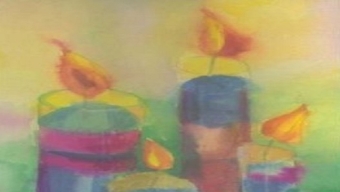For as the sun shines on Candlemas Day,
So far will the snow swirl until May.
For as the snow blows on Candlemas Day,
So far will the sun shine before May.
On February 2nd, it’s time to celebrate Candlemas, Imbolg, or Brigid’s Day (all names work, depending on your beliefs). It’s time to recognize that winter is on its way out, the light is beginning to return, and spring is finally on its way! It is a great time to do rituals involving the hearth and home. If you have a fireplace, give it a good cleaning along with the rest of your house, and celebrate Candlemas with a nice hearty fire. If you have any Yule greenery left over, then this is the time to gather it up and toss it in the flames.
During the fourth century, Christians began commemorating the day that Mary and Joseph brought Jesus to the temple. By Jewish law, that would have been the fortieth day after His birth. (Luke 2:21-38). You may remember that a prophet named Simeon predicted that Jesus would bring “a light of revelation to the Gentiles.” So the feast day became associated with candles. Each community’s elder or priest would pray a blessing over candles, then pass them out for people to take into their homes. Eventually the celebration came to be called Candlemas. The verse “I Am the Light of the World ” (John chp 8 vs 12) is connected with Candlemas.
During the middle ages and renaissance, the feast took on other meanings. In parts of England, Candlemas became the day to take down your Christmas greenery and start spring cleaning. And, as the opening poem shows, many Europeans adopted a superstition that a sunny Candlemas foretold a late, cool spring.
Whether Candlemas be dark or clear, forty days of winter will still be here.
February 2 is also the middle of winter as astronomers calculate it (the mid-point between the Winter Solstice and Spring Equinox). Pre-Christian Celtic cultures celebrated this time of year by holding ceremonies to bless the spring planting. It’s also known as Imbolic. Imbolc is a melting pot mixture of Celtic, Roman, and Christian traditions — and even briefly mention a few holidays not from Europe, such as Setbun, the Japanese Bean Throwing and Lantern Festival; Li Chum, the Chinese Spring Festival; and Holi, the Hindu Festival of Colour. Pretty amazing, isn’t it – how all people’s of the world find their unique ways to celebrate and recognize the change of seasons.
February 2nd has one of the richest traditional textures of any holiday we celebrate. And yet, we barely celebrate it today. Sadly, the only things most North Americans associate with February 2nd are Punxsutawney Phil and the movie Groundhog Day. There is remembrance in Europe, where they make crêpes (very think pancakes) for Candlemas. Crêpes remind us of the sun, which we’re craving.
To me, those modern additions are like the stones I once found in my back yard – only a few corners showed above the soil, but a whole limestone foundation from a long-leveled building lay just under the sod. Before we disparage the modern remnants of the holiday, and maybe the whole holiday with it, it might be good to take a closer look at how Groundhog Day contributes to the richly woven tapestry of this season. Then, maybe we can decide what, if anything, February 2nd “means,” or “should mean,” or could mean, if we took the time to think about it.
<A HREF=”http://ws.amazon.com/widgets/q?rt=tf_cw&ServiceVersion=20070822&MarketPlace=US&ID=V20070822%2FUS%2Fwaldorfhomesc-20%2F8010%2F23fd30e2-d3f3-44e8-a77a-37ec5ad882b6&Operation=NoScript”>Amazon.com Widgets</A>Instead of making a list of New Years’ resolutions you can’t keep, what about taking one part of your life that could stand improvement and working on that, a little bit every day for a year?
To use a metaphor that is appropriate for the feast day, you are lighting one candle at a time, and not trying to keep a whole candelabra going until you’re ready for it. Next year you add another candle, and so on.
Maybe you could do one nice thing, unasked, for a family member, every day. Or learn one new word in French, or read one chapter of the New Testament, or do one physical exercise, or write one line of a poem, or send one note of encouragement to a friend, or say one kind word to one stranger.
When sleet blinds you,
hail drowns out voices,
and snow hides your path,
may you discern in each flake
a star, image of the one
that guided the Magi,
and find that in the pain
of birth, death or change
there is a light
to guide you.
This is a simple way to make life on earth a little better for those around you and for yourself, too!
Brigid is the goddess of creative inspiration as well as reproductive fertility. This is a good time for sharing creative work, or, if you don’t think of yourself as especially creative, an idea that worked or a plan that materialized. Thank the Goddess for her inspiration, perhaps by dedicating a future work to her.
Since Candlemas is a time of new beginnings, this is a good day to ritually celebrate all things new. Plan a ceremony to name a new baby, officially welcome a new person into a family or plight your troth to your beloved. Make a commitment to a goal (like a New Years resolution): this would be an especially powerful thing to do in a group.
If you plan your own ceremony, use these two powerful symbols: fire and water. For instance, wash your hands and bathe your face in salt water, which is especially good for purification. Light a candle as you make your pledge. Incorporate the third symbol of the holiday — seeds — by planting a seed or bulb in a pot to symbolize your commitment, or by blessing a bowl or packet of seeds that you will plant later.
You don’t have to be Catholic to gain spiritual benefits from the voluntary surrender of something you cherish. You can give up something frivolous or something serious, but it should be something you will notice. Folk wisdom says it takes six weeks (or approximately the 40 days of Lent) to establish a new habit, so you may end up with a lifestyle change.
Since Candlemas is often considered the beginning of spring, you can perform another ritual act of purification: spring cleaning. This would be a good time to do a thorough house cleaning, sweeping the floors with salt water, banishing the gloom of winter and creating a sparkling, shiny new setting for spring.
Here are some Reading suggestions:
<A HREF=”http://ws.amazon.com/widgets/q?rt=tf_cw&ServiceVersion=20070822&MarketPlace=US&ID=V20070822%2FUS%2Fwaldorfhomesc-20%2F8010%2F8f13f5ae-c09a-4880-baa9-dcf1bbfff775&Operation=NoScript”>Amazon.com Widgets</A>
Candlemas Day Verse
If Candlemas Day be fair and bright
Winter will have another flight.
If Candlemas Day brings cloud and rain,
Winter won’t come again.
If Candlemas Day be dry and fair,
The half o the winter’s to come and mair;
If Candlemas Day be wet and foul,
The half o the winter’s gane at Yule.
Candlemas Verse from colonial Williamsburg, 18th century
When New Year’s Day is past and gone;
Christmas is with some people done;
But further some will it extend,
And at Twelfth Day their Christmas end.
Some people stretch it further yet,
At Candlemas they finish it.
The gentry carry it further still
And finish it just when they will;
They drink good wine and eat good cheer
And keep their Christmas all the year.
Candlemas Day (Verse from Scottish Quarter Day)
If Candlemas Day be dry and fair,
Half the winter’s to come and mair.
If Candlemas Day be wet and foul,
Half o’ winter’s gane at Yule.
(Meaning of unusual words: mair=more, Yule=Christmas)
A Song for Candlemas by Lizette Woodworth Reese
There’s never a rose upon the bush,
And never a bud on any tree;
In wood and field nor hint nor sign
Of one green thing for you or me.
Come in, come in, sweet love of mine,
And let the bitter weather be!
Coated with ice the garden wall;
The river reeds are stark and still;
The wind goes plunging to the sea,
And last week’s flakes the hollows fill.
Come in, come in, sweet love, to me,
And let the year blow as it will!
Candlemas Day by Frances Ridley Havergal
YES, take the greenery away
That smiled to welcome Christmas Day,
Untwine the drooping ivy spray.
The holly leaves are dusty all,
Whose glossy darkness robed the wall,
And one by one the berries fall.
Take down the yew, for with a touch
The leaflets drop, as -wearied much
With light and song, unused to such.
Poor evergreens! Why proudly claim
The glory of your lovely name,
So soon meet only for the flame?
Another Christmas Day will show
Another green and scarlet glow,
A fresh array of mistletoe.
And this new beauty, arch or crown,
Will stiffen, gather dust, grow brown,
And in its turn be taken down.
To-night the walls will seem so bare!
Ah, well! look out, look up, for there
The Christmas stars are always fair.
They will be shining just as clear
Another and another year,
O’er all our darkened hemisphere.
So Christmas mirth has fleeted fast,
The songs of time can never last,
And all is buried with the past.
But Christmas love and joy and peace
Shall never fade and never cease,
Of God’s goodwill the rich increase.
Time of Candles
The season of festivities has ended.
The final yuletide greenery has died.
The land seems dull and drab and dreary.
It’s time to celebrate the feast of Bride.
The rain and melting snow have filled the rivers
whose waters wash the land free of decay.
The winter storms have culled the rotten branches
of trees and swept the autumn leaves away.
The frost has broken up the stubborn clay.
The icy air has purified the land.
And Mother Earth has suffered winters purging
no less than us, though ordained by her hand.
Through the worst of winter’s devastation
signs of approaching spring can now be found.
And everywhere green shoots appear even
through suffocating snow, ice hardened ground.
The slimmest spears of snowdrops pale and white
push through the earth; the symbol of the spring’s
return. The yellow pollen of the catkins
heralds the bounty which the season brings.
In still drab fields the lambs are seen at play;
the first born creatures of the infant year;
carefree and nurtured by their mothers milk
as Mother Earth feeds all her children dear.
Though the approaching spring is still a whisper
at Candlemas we celebrate her youth.
Pure white candles burning to remind us
to leave behind the past and seek for truth.
While human hands are turning to spring cleaning
and human thoughts consider youthful themes.
So human spirits will begin their quest
afresh and human hearts will dream new dreams.
Candlemas Eve Carol by Robert Herrick (1591-1674)
1. Down with the rosemary and bays,
Down with the mistletoe ;
Instead of holly, now up-raise
The greener box, for show.
Refrain:
Thus times and seasons oft do shift; each thing his turn doth hold ;
New thoughts and things now do succeed, as former things grow old.
2. The holly hitherto did sway ;
Let box now domineer
Until the dancing Easter day,
Or Easter’s eve appear. Refrain
3. Then youthful box which now hath grace
Your houses to renew ;
Grown old, surrender must his place
Unto the crisped yew. Refrain
4. When yew is out, then birch comes in,
And many flowers beside ;
Both of a fresh and fragrant kin
To honour Whitsuntide. Refrain
5. Green rushes, then, and sweetest bents,
With cooler oaken boughs,
Come in for comely ornaments
To re-adorn the house. Refrain
Get more inspiring articles by Like’ing our Facebook Page Here >>




















